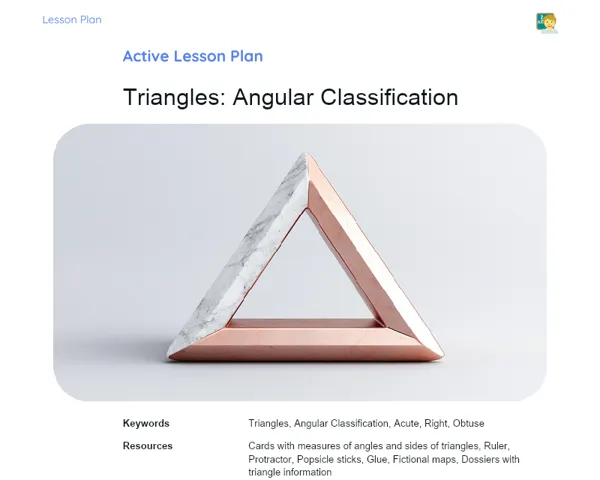Lesson Plan | Lesson Plan Tradisional | Triangles: Law of Cosines
| Keywords | Law of Cosines, Triangles, Trigonometry, Pythagorean Theorem, Angles, Sides of Triangles, Geometric Problems, Practical Examples, Demonstrations, Problem Solving, Engineering, Navigation, Astronomy |
| Resources | Whiteboard, Markers or Chalk, Calculators, Ruler, Protractor, Projector (if available), Slides with explanatory content, Worksheets, Pens and pencils, Eraser |
Objectives
Duration: 10 - 15 minutes
This stage aims to equip students with a solid understanding of the essential concepts related to the Law of Cosines. With this knowledge, learners can use it in real-life contexts, like solving geometric challenges that require finding the sides or angles of triangles. This foundational understanding is crucial for the activities that follow.
Objectives Utama:
1. Explain the Law of Cosines in detail and its mathematical formula (a² = b² + c² - 2bc cos α).
2. Show how to apply the Law of Cosines to work out the sides of a triangle.
3. Teach students how to find the angle of a triangle when the cosine is known.
Introduction
Duration: 10 - 15 minutes
This stage aims to equip students with a solid understanding of the essential concepts related to the Law of Cosines. With this knowledge, learners can use it in real-life contexts, like solving geometric challenges that require finding the sides or angles of triangles. This foundational understanding is crucial for the activities that follow.
Did you know?
Did you know that the Law of Cosines is frequently employed in navigation and astronomy? For instance, it can calculate the distance between two points on the Earth's surface, which is crucial for maritime and aerial navigation. Furthermore, civil engineers use this law to assess the stability of structures, such as bridges and buildings.
Contextualization
In kicking off our lesson on the Law of Cosines, it’s vital to remember that we’re focusing on triangles, which are fundamental geometric shapes prevalent in fields like architecture and engineering. The Law of Cosines is an invaluable tool that helps us solve oblique triangles, those lacking a right angle. This law generalises the Pythagorean Theorem and is particularly useful when we know two sides and the angle between them or all three sides and need to find a specific angle.
Concepts
Duration: 60 - 70 minutes
This stage aims to deepen students' understanding of the Law of Cosines, ensuring they can apply the formula in various contexts and solve numerous problems. This understanding is crucial for their academic pursuits and future practical problem-solving.
Relevant Topics
1. Definition of the Law of Cosines: Explain the formula for the Law of Cosines (a² = b² + c² - 2bc cos α) and stress that it extends the Pythagorean Theorem for oblique triangles. Emphasise that this law can determine an unknown side when two sides and the angle are known or to find an angle when all sides are provided.
2. Demonstration of the Law of Cosines: Present the Law of Cosines using vector decomposition and trigonometry. Highlighting the formula's origin is important for solidifying students' comprehension.
3. Practical Applications of the Law of Cosines: Share real-world examples of how the Law of Cosines is applied in areas like navigation, engineering, and astronomy. Provide a detailed example from each field to demonstrate the formula's application.
4. Solved Examples: Tackle problems on the board step by step to show how to use the Law of Cosines for calculating unknown sides and angles. Include a diverse range of examples, from straightforward to complex, ensuring all students can follow and understand.
To Reinforce Learning
1. If a triangle has sides measuring 7 cm, 10 cm, and an angle of 45° between them, calculate the length of the unknown side.
2. In a triangle with sides measuring 8 cm, 6 cm, and 5 cm, determine the angle opposite the 5 cm side.
3. An engineer needs to find the distance between two points on a triangular piece of land. The sides measure 50 m and 40 m, with an included angle of 60°. What is the distance between these points?
Feedback
Duration: 15 - 20 minutes
This stage serves to cement learning by enabling students to review and discuss the answers to the questions presented. This process reinforces their understanding of the Law of Cosines and its practical applications while fostering an environment for clarifying uncertainties and reflecting on challenges faced.
Diskusi Concepts
1. 💡 Discussion of Question 1: For a triangle with sides of 7 cm, 10 cm, and an angle of 45° between them, calculate the length of the unknown side. 2. Utilise the Law of Cosines formula: a² = b² + c² - 2bc cos α. 3. Substitute the known values: a² = 7² + 10² - 2(7)(10) cos 45°. 4. Calculate: a² = 49 + 100 - 2(7)(10)(0.7071). 5. Simplify: a² = 149 - 99.994 ≈ 49.006. 6. Extract the square root: a ≈ 7.00 cm. 7. 👉 The unknown side measures approximately 7 cm. 8. 💡 Discussion of Question 2: For a triangle with sides of 8 cm, 6 cm, and 5 cm, determine the angle opposite the 5 cm side. 9. Use the Law of Cosines formula: cos α = (b² + c² - a²) / 2bc. 10. Substitute the known values: cos α = (6² + 8² - 5²) / 2(6)(8). 11. Calculate: cos α = (36 + 64 - 25) / 96. 12. Simplify: cos α = 75 / 96 ≈ 0.78125. 13. Use the inverse cosine function: α ≈ cos⁻¹(0.78125). 14. Calculate: α ≈ 38.68°. 15. 👉 The angle opposite the 5 cm side is approximately 38.68°. 16. 💡 Discussion of Question 3: An engineer needs to calculate the distance between two points on a triangular plot of land. The sides are 50 m, 40 m, with a 60° angle between them. What’s the distance between these points? 17. Use the Law of Cosines formula: a² = b² + c² - 2bc cos α. 18. Substitute the known values: a² = 50² + 40² - 2(50)(40) cos 60°. 19. Calculate: a² = 2500 + 1600 - 2(50)(40)(0.5). 20. Simplify: a² = 4100 - 2000 = 2100. 21. Extract the square root: a ≈ 45.83 m. 22. 👉 The distance between the two points is approximately 45.83 m.
Engaging Students
1. ❓ Questions and Reflections 2. Why is the Law of Cosines important for oblique triangles? 3. How can we view the Law of Cosines as an extension of the Pythagorean Theorem? 4. In what real-life contexts can you apply the Law of Cosines? 5. Did you face any challenges when using the Law of Cosines? If so, what were they? 6. How does the accuracy of cosine values impact final calculations? 7. Which of the examples discussed did you find most intriguing? Why?
Conclusion
Duration: 10 - 15 minutes
This stage consolidates learning by summarising the key concepts discussed in the lesson, reinforcing the connection between theory and practice. This structured review allows students to understand the topic's significance and prepare to apply the Law of Cosines in future scenarios. It also provides a moment for reflection and clarification of any remaining uncertainties, ensuring a comprehensive understanding of the subject.
Summary
['The Law of Cosines is a mathematical formula used to determine the sides and angles of oblique triangles.', 'The formula is: a² = b² + c² - 2bc cos α.', 'The Law of Cosines can be conceived as a generalisation of the Pythagorean Theorem.', 'It helps calculate an unknown side when two sides and the included angle are known, or identifies an angle when all sides are provided.', 'The Law of Cosines finds utility in numerous sectors, such as navigation, engineering, and astronomy.']
Connection
This lesson bridged theory with practice by demonstrating the Law of Cosines' application in real-world problems, such as calculating distances in triangular plots and determining angles in structures. The step-by-step resolved examples illustrated how the formula can be utilised in various contexts, enhancing students' understanding of its importance and application in solving intricate geometric problems.
Theme Relevance
The Law of Cosines is a vital tool in mathematics and applied sciences, enabling the resolution of challenges associated with oblique triangles. It's essential in several practical fields, including engineering for ensuring structural stability, navigation for calculating distances across the Earth, and astronomy for determining star positions. Grasping this law enhances students' capabilities to tackle complex problems and apply them in real-world situations.


